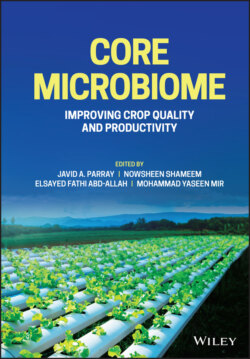Читать книгу Core Microbiome - Группа авторов - Страница 23
2.2.3 Plant Disease Management
ОглавлениеEvery natural soil can suppress pathogens to a certain level; this phenomenon is called general disease suppression, and it depends on the total microbial biomass. Specific suppression comes into the picture when an individual or group of microorganisms causes soil to suppress disease [32]. Some soil can retain its condition by suppressing activity for a long time, while some could develop after several years of monoculture. Moreover, the establishment of disease suppression in soil was described for several diseases. In an experiment conducted on a tomato plant, a susceptible cultivar was treated with rhizosphere microbiota of resistant cultivar, which suppressed disease symptoms.
Further analysis showed that flavobacterium TRM1 could antagonize R. solanacearum and inhibited the progress of bacterial wilt in tomatoes [33]. A root disease termed as “take-all” of Triticum aestivum caused by Gaeumannomyces graminis var. tritici was suppressed through several years of monoculture in soil by disease-suppressive microorganisms. This phenomenon is called “take-all decline,” which is associated with the antagonistic activity of fluorescent Pseudomonas spp. by the antifungal compound 2,4-diacetylphloroglucinol (DAPG) [32]. Soil metagenomics study of potato plants associated with potato common scab disease revealed a positive correlation between pathogenic Streptomyces and scab severity but negative correlation with Geobacillus, Curtobacterium unclassified Geodermatophilaceae [34]. Some commercial products such as “Mycostop,” containing Streptomyces griseoviridis strain, which can suppress root rot and wilt diseases by occupying the rhizosphere are also available [35], “BlightBan A506” containing P. Fluorescens can control fire blight frost damage in fruits caused by Erwinia amylovora and “Epic Kodiak” to target Rhizoctonia solani by Bacillus subtilis [36]. A microbial consortium containing four isolates, Serratia marcescens isolate 59, Pseudomonas fluorescens 57, Rahnella aquatilis 36, and Bacillus amyloliquefaciens 63 was able to increase soil disease suppression ability against Fusarium spp. in chickpea rhizosphere, which causes wilt and root rot [37].
Various management practices in combination or isolation are being used to suppress diseases, including intercropping, organic amendments, crop rotation, and tillage management. Several years of monoculture of one variety in the same field causes replanting disease. Intercropping changes root exudates that alter the rhizospheric microbiome. An experiment with intraspecific intercropping on Radix pseudostellariae plant increased beneficial Nitrosomonadales, Nitrospirales, Pseudomonadales, and decreased pathogenic Aspergillus and Talaromyces [38]. Atractylodes lancea, a medicinal plant, suppressed Fusarium oxysporum mediated root rot disease in peanut while used as inter-crop [39] and while intercropping with aerobic rice, conquered Fusarium oxysporum mediated watermelon wilt [40]. Intercropping between maize and soybean can cause phenolic acid-mediated inhibition of Phytophthora sojae, responsible for Phytophthora blight of soybean [41]. Reduced conventional tillage practices increase organic matter, which prevents C. sativus from germinating and changes nutrient availability, which influences pathogen survival. Crop rotation changes root exudates and compounds released from crop residue decomposition, which affects the rhizosphere microbial community. Fungicide compounds released from canola residues breakdown procedure can diminish the extremity of common root rot in cereals [42]. Animal manures and organic composts also influence plant pathogens. Providing beneficial microbiota from compost to conductive soil remains the critical strategy for increasing suppression against soilborne pathogens. Five compost–peat mixtures were used to control Pythium ultimum, Rhizoctonia solani, and Sclerotinia minor – Lepidium sativum to manage dumping off diseases [43]. Combining effort with selective biological control agents, organic amendments, and suppressive disease compost can achieve natural disease control against soilborne pathogens. A positive balance is obligatory between phytopathogens and beneficial microorganisms to obtain optimal plant growth and health.
